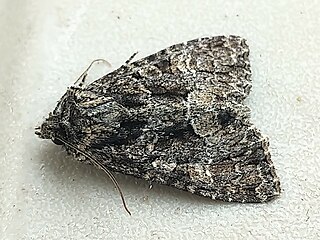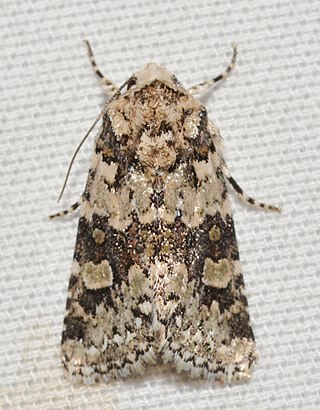Phlyctaina is a monotypic litter moth genus of the family Erebidae. Its only species, Phlyctaina irrigualis, is found in North America. Both the genus and species were first described by Heinrich Benno Möschler in 1890.

Platypolia mactata, the adorable brocade, is a species of cutworm or dart moth in the family Noctuidae. It is found in North America.
Condica temecula is a species of moth in the family Noctuidae. It was first described by William Barnes in 1905 and it is found in North America.
Lacinipolia longiclava is a species of cutworm or dart moth in the family Noctuidae. It is found in North America.
Dichagyris socorro is a species of cutworm or dart moth in the family Noctuidae. It was first described by William Barnes in 1904 and it is found in North America.
Sigela eoides, the youthful sigela moth, is a species of moth in the family Erebidae. It was first described by William Barnes and James Halliday McDunnough in 1913 and it is found in North America.

Oslaria viridifera, the green oslaria, is a moth in the family Noctuidae. The species was first described by Augustus Radcliffe Grote in 1882. It is found in North America.
Anarta inconcinna is a species of cutworm or dart moth in the family Noctuidae. It was first described by Smith in 1888 and it is found in North America.
Lacinipolia anguina, the snaky arches, is a species of cutworm or dart moth in the family Noctuidae. It is found in North America.
Lacinipolia aileenae is a moth genus or species of cutworm or dart moth in the family Noctuidae. It is found in North America.

Lacinipolia buscki is a species of cutworm or dart moth in the family Noctuidae first described by William Barnes and Foster Hendrickson Benjamin in 1927. It is found in Australia and North America.
Lacinipolia rodora is a species of cutworm or dart moth in the family Noctuidae.
Lacinipolia mimula is a species of cutworm or dart moth in the family Noctuidae.

Condica charada is a species of moth in the family Noctuidae. It is found in North America.

Azenia virida is a species of moth in the family Noctuidae. It was first described by William Barnes and James Halliday McDunnough in 1916 and it is found in North America.
Lacinipolia spiculosa is a species of cutworm or dart moth in the family Noctuidae. It is found in North America.

Paectes pygmaea, the pygmy paectes, is a moth in the family Euteliidae. The species was first described by Jacob Hübner in 1818. It is found in North America.
Proxenus mindara, the rough-skinned cutworm moth, is a species of cutworm or dart moth in the family Noctuidae. It was first described by William Barnes and James Halliday McDunnough in 1913 and it is found in North America.
Cucullia pulla is a species of moth in the family Noctuidae. It was first described by Augustus Radcliffe Grote in 1881 and it is found in North America.
Cryphia sarepta is a species of moth in the family Noctuidae. It was first described by William Barnes in 1907 and it is found in North America.





